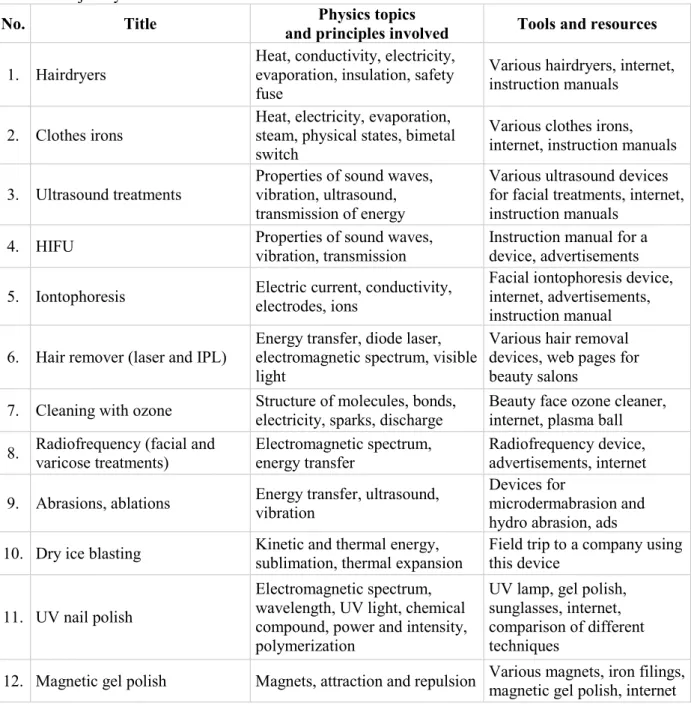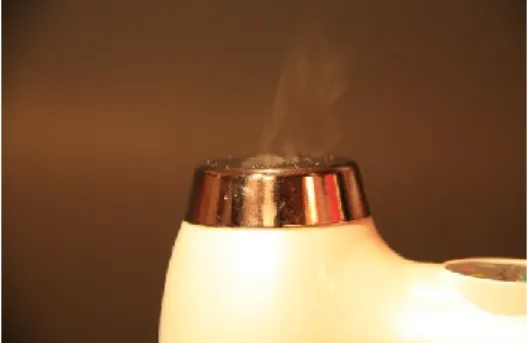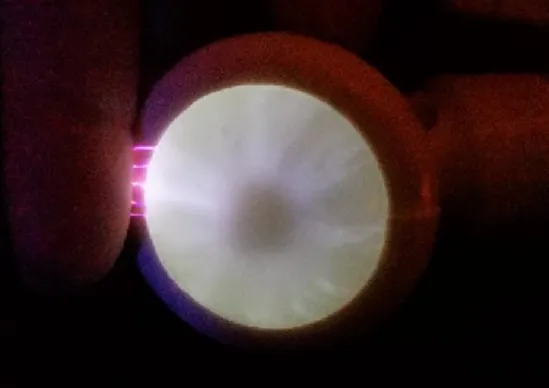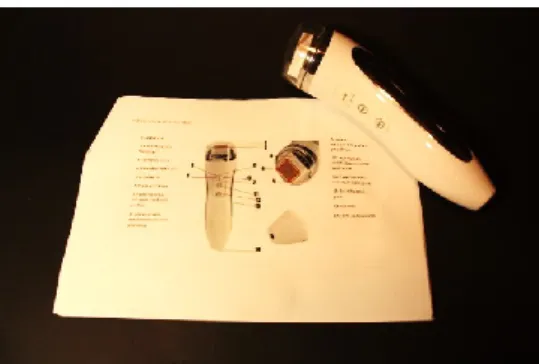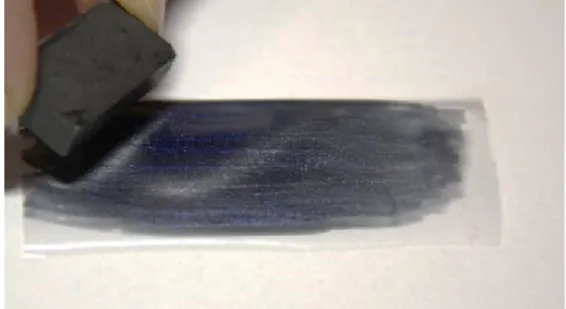PAPER • OPEN ACCESS
Beauty and physics — Physics projects based on modern aesthetic and medical treatments
To cite this article: Anett Nagy 2021 J. Phys.: Conf. Ser. 1929 012027
View the article online for updates and enhancements.
This content was downloaded from IP address 188.6.107.11 on 29/09/2021 at 21:41
Beauty and physics – Physics projects based on modern aesthetic and medical treatments
1Anett NAGY,
Radnóti Miklós Experimental Secondary Grammar School and MTA–SZTE Science Education Research Group, Szeged, Hungary
Abstract. As a natural science, physics seeks to answer questions that arise in the world around us. One of the areas of motivation is to show students that a number of devices and treatments used in the beauty industry or for staying healthy apply the laws and phenomena of physics.
Examining the physical background of various, modern treatments can be used to raise simple and complicated issues in physics and also provides us the opportunity to carry out qualitative or quantitative experiments. We believe that these projects assist students in a better understanding of physics and also encourage teachers to make the subject more interesting.
1. Introduction
“Pure logical thinking cannot yield us any knowledge of the empirical world; all knowledge of reality starts from experience and ends in it.” (Albert Einstein)
As a natural science, physics seeks to answer the questions that arise in the world around us. Our knowledge of physics helps us understand natural phenomena and the important effects influencing human life.
Still, currently, the standing and popularity of physics as a school subject are negative both in Hungary and in abroad [1]. Recently, many scientists and teachers have endeavoured to change this disadvantageous situation by developing more and more up-to-date methods. Naturally, no best solution exists, and most probably, the future will not bring us the one and only method that will give students a sufficient impetus for their academic efforts in all circumstances. In my study, therefore, I introduce a project-based method that has the potential to increase the popularity of physics as a school subject in secondary or higher education using new scientific content.
One of the areas of motivation is to show students that numerous devices and treatments used in the beauty industry or for staying healthy apply the laws and phenomena of physics. These topics create chances for students to relate the lesson content to reality [2]. In this context, we present a term-long, project-based programme in which students investigated the working principle of an electric device or a medical treatment week by week.
2. Results and discussions 2.1. The structure of the project
Electric devices such as a flat iron or hair dryer, facial ozone streamer, or impulse light or laser hair remover, can both raise and sustain students’ interest, while examining the physical backgroundof these
1This study was funded by the Content Pedagogy Research Programme of the Hungarian Academy of
2
devices. They can be used to raise simple and complex issues, and they also provide us the opportunity to carry out qualitative or quantitative experiments. Although these treatments and devices seem to be mostly for girls at first sight, after the investigation students realise that most of these treatment methods are used in other areas as well.
During the first term, students (aged 16–17) took part in twelve projects in which they investigated twelve different modern beauty or medical treatments advertised in various media, finding the basic principles of physics behind the procedure and conducting experiments with the available devices. We used older, non-working devices as well, and we dismantled them to see what lies beneath the cover.
Students also read the instruction manuals, found statements and expressions that refer to physical phenomena and looked for scientifically improper expressions as well. Titles and tools for the twelve different projects are collected in table 1.
Table 1. Project syllabi
No. Title Physics topics
and principles involved Tools and resources 1. Hairdryers
Heat, conductivity, electricity, evaporation, insulation, safety fuse
Various hairdryers, internet, instruction manuals
2. Clothes irons
Heat, electricity, evaporation, steam, physical states, bimetal switch
Various clothes irons, internet, instruction manuals 3. Ultrasound treatments Properties of sound waves,
vibration, ultrasound, transmission of energy
Various ultrasound devices for facial treatments, internet, instruction manuals
4. HIFU Properties of sound waves,
vibration, transmission
Instruction manual for a device, advertisements 5. Iontophoresis Electric current, conductivity,
electrodes, ions
Facial iontophoresis device, internet, advertisements, instruction manual 6. Hair remover (laser and IPL)
Energy transfer, diode laser, electromagnetic spectrum, visible light
Various hair removal devices, web pages for beauty salons
7. Cleaning with ozone Structure of molecules, bonds, electricity, sparks, discharge
Beauty face ozone cleaner, internet, plasma ball 8. Radiofrequency (facial and
varicose treatments)
Electromagnetic spectrum, energy transfer
Radiofrequency device, advertisements, internet 9. Abrasions, ablations Energy transfer, ultrasound,
vibration
Devices for
microdermabrasion and hydro abrasion, ads 10. Dry ice blasting Kinetic and thermal energy,
sublimation, thermal expansion
Field trip to a company using this device
11. UV nail polish
Electromagnetic spectrum, wavelength, UV light, chemical compound, power and intensity, polymerization
UV lamp, gel polish, sunglasses, internet, comparison of different techniques
12. Magnetic gel polish Magnets, attraction and repulsion Various magnets, iron filings, magnetic gel polish, internet
2.2. Introduction and basic phenomena of physics in certain projects.
After a short discussion of the basic topic, groups of students visit each of the stations which have been prepared for a particular project on a particular project day. Usually, one group works on tablets and looks for the mechanism of a certain device and the physical principles behind its effect. Another group investigates the device and instruction manuals, while the third group looks for the application of the phenomena in real life. The last group visits homepages for various beauty salons advertising that particular treatment. They compare the scientific information offered about the treatment and the device used for it.
For example, radiofrequency is a non-invasive wrinkle treatment, in which thermal energy warms the deep layers of the skin to stimulate collagen production and promote tissue contraction for improved skin quality. Students learn that radio waves can be used in the beauty industry not only for wrinkle removal, but also for varicose vein treatments, as the working effect is based on the same principle:
using heat energy transferred in radio waves [3].
After every 20 minutes, the students go to another station, so by the end of the class they visit all the stations and complete all the hand-outs prepared for them. Finally, they share their experiences with each other and summarize the findings of their investigations. The following subsections demonstrate the physics content of these projects.
2.2.1. Ultrasonic treatments. Ultrasound is a sound wave with frequencies higher than the upper audible limit of human hearing. Ultrasound devices operate with frequencies from 20 kHz up to several GHz and are used to detect objects and measure distances. Ultrasound imaging or sonography is often used in medicine, for example, during pregnancy. In the non-destructive testing of products and structures, ultrasound is used to detect invisible flaws. In industry, ultrasound is used for cleaning, mixing and accelerating chemical processes. Animals, such as bats and porpoises, use ultrasound for locating prey and obstacles. This is called echolocation.
Figure 1. A drop of water on the ultrasound head vibrates, breaking down into tiny particles and
forming steam above the head.
In the beauty industry, ultrasound devices are used for treating wrinkles and for tightening skin. As the ultrasound produced by the skin tightening device (figure 1) reaches 5 mm deep under the skin, it penetrates into the second layer of muscles under the facial muscles. In that layer of the skin, called the dermis, new collagen is produced. The amount of collagen decreases with age as the oestrogen level in women decreases after menopause. This leaves the skin drier, thinner and not as taut as before. Once the dermis begins producing the new collagen, sagging facial and neck skin is lifted and starts to look younger and tighter.
High-intensity focused ultrasound (HIFU) is an innovative, painless and non-invasive way to reduce wrinkles to lift the face and brow. HIFU therapy differs from ultrasound imaging in that the waves are of a higher intensity and are focused on a single point. The mechanism of HIFU therapeutic action takes two forms: conversion of mechanical energy into heat and mechanical cavitation of pressure waves in tissues.
4
By focusing the ultrasound waves on a particular spot in the body, the energy converted to heat causes the tissue to heat up, thus killing the cells in the tissue. Highly concentrated ultrasound waves penetrate deep into the skin and stimulate collagen and elastin production. As the temperature rises above the 65oC coagulation point, an immediate tightening effect, such as the contraction of skin, occurs. A long-term skin tightening effect or skin remodelling is enhanced by the new collagen and elastin production. HIFU treatment is similar to other ablation techniques, such as radio frequency ablation and cryoablation [4].
The other therapeutic action of HIFU is through cavitation. It makes the tissue vibrate and mechanically stress the cells, also causing them to die [5]. During the treatment, a slight discomfort may be experienced, and tiny electric pulses or a light prickly sensation can be felt [6]. This completely non- invasive technology has great potential for tumour ablation as well as haemostasis, thrombolysis and targeted drug/gene delivery [7].
2.2.2. Iontophoresis. An iontophoresis device applies a charge to the skin, which changes the skin’s resistance, enhancing the amount of medication that can travel below its surface. Transdermal medication delivery by iontophoresis is largely accomplished by using a single patch containing a positive and negative electrode that adheres directly to the skin. One side of the electrode is filled with the selected medication, and the other is filled with standard saline. While electrode configurations and shapes vary, they all allow good skin contact around surfaces and changes in dosing. There are different electrodes from 40mA/min to 80mA/min, and the medication dosages are based on drug properties.
Most electrodes are manufactured to be consistent with a 0.5 mA/cm2 current density [8].
2.2.3. Diode laser hair removal. The key principle behind laser hair removal is matching specific wavelengths of light and pulse duration to a specific target, namely the melanin in a hair follicle. Melanin is the naturally occurring pigment in our skin and hair associated with colour. Light is absorbed by dark objects but reflected by light objects and water, so laser energy can be absorbed by dark material in the hair or skin, with much more speed and intensity than skin without any dark adult hair or melanin.
The success of diode laser hair removal depends on the delivery of high energy into the skin. The energy is selectively absorbed by the melanin surrounding the follicles, whilst not impacting the surrounding tissue. Diode lasers use a single wavelength of light that has a high abruption rate in melanin. As the melanin heats up, it destroys the root and blood flow to the follicles, disabling hair growth permanently. High-quality laser hair removal machines that incorporate crystal freeze refrigeration contact cooling (+5ºC) to protect the surface of the skin make the treatment a comfortable, pain-free experience for patients.
Using professional strength 808nm diode laser technology, the device targets the pigment of follicles, while the transmitted energy destroys the follicles. The disabled hair begins to fall out, and the follicles lose their hair regrowth ability. As hair grows in different stages, growing, resting and shedding, only 15% of hair is in the growth stage at any given time, so multiple treatments are needed to disable all the follicles [9].
Intense pulsed light (IPL) technology is another treatment to remove unnecessary hair. It uses a broad spectrum of light from a xenon flash lamp that emits a full spectrum light wavelength between 400 nm and 1200 nm. A wide range of wavelengths represents unfocused energy around the hair and skin area [10]. As a result, there is a great waste of energy and less selective absorption in the follicles, resulting in less effective destruction of the hair. Using broadband light also increases the potential for side- effects, such as burns or pigmentation, particularly if integrated cooling is not used. IPLs are typically only suitable for lighter skin types [11].
2.2.4. Cleaning with ozone. Ozone contains three atoms of oxygen instead of the basic two atoms. It is formed by the action of UV (ultraviolet) light and electric discharges within the Earth’s atmosphere.
The additional third atom makes the molecule an unstable, highly reactive gas. This is why it is the most powerful sterilizer in the world. It was discovered in 1840, named after a verb in Greek ozein, which means “to smell”, due to its distinctive smell. Ozone is a pale blue gas, presented in the highest
concentration high in the ozone layer of the stratosphere, which absorbs most of the Sun’s ultraviolet radiation wavelengths from about 200 nm UV rays to 315 nm.
Figure 2. Discharges between my finger and the surface of the ozone cleaner
Ozone can be used in different ways, mostly as a substitute for chemical sanitizers. Ozone can sanitize swimming pools and spas, disinfect laundry in hospitals or ski boots. Large ozone generators are used to decontaminate operating rooms in hospitals or classrooms in schools and kindergartens. These rooms are cleaned first and then sealed airtight before being filled with ozone. After an epidemic, ozone can kill almost all the remaining bacteria in the rooms.
Based on the same principle, ozone can be used for aesthetic treatments as well. For example, in ozone steamers, an ultraviolet lamp converts O2 into O3, which is then expelled by the diffuser. The ozone reaching the skin purifies and oxygenates it, hydrates the epidermis and aids in the elimination of toxins. An ozone facial beauty massager uses a low-frequency circuit that generates ozone when the head of the machine touches the skin, disinfecting and treating acne and spots (figure 2). It also stimulates the regeneration of collagen, firming and fading deep wrinkles [12].
2.2.5. Radiofrequency. Radiofrequency can be used in many ways on the face or on the entire body, treating wrinkles on the face, shaping the body or replacing surgery of the varicose veins. Although these treatments target different areas of the body with different aims, they all have the same basic principle of physics behind them. The common feature of these procedures is that radiofrequency energy heats up and damages certain cells. A radiofrequency wave causing burning-like effects in deeper layers of the skin stimulates production of new collagen, which helps firm wrinkles and causes an anti-ageing effect. Figs. 3 and 4 show an RF machine and the electrodes on its head.
The multipolar radiofrequency energy in facial treatments penetrates the layers of the skin to selectively heat the skin tissue and the extracellular matrix where the collagen fibres are embedded. The local heating stimulates the collagen fibres and fibroblast cells to produce new collagen and elastic fibres. The result is tighter, smoother, younger-looking skin with a visible lift.
In varicose veins, this energy heats up and damages the walls inside a vein, which closes off that vein in the leg. During this procedure, a thin tube called a catheter is inserted through a small incision in the vein. Radiofrequency energy is directed through this tube, and soon it closes off the varicose veins using only local anaesthesia. The recovery period is quite short compared to surgery. After the treatment, the patient has to wear compression stockings for a few weeks. The success of the treatment is checked after a month with the ultrasound technique to detect the presence or absence of flow in the treated veins [13].
6
Figure 3. Radiofrequency machine with instruction manual
Figure 4. The head with 144 electrodes In body treatments, radiofrequency is the best available technology for non-invasive, non-surgical skin tightening and cellulite removal. The energy transmitted in radiofrequency delivers intense heat to tissues deeper than the epidermis. It aims to boost collagen production, circulation and fat release from those issues. The physics behind this technique is that high-frequency electric currents of 400kHz–
40MHz penetrate the superficial layers of the skin without heating them, only heating targeted tissues.
For example, the collagen-producing cells are located in the middle skin layer, the dermis, but fat tissue is located in the deepest skin layers. Different layers of the skin can be treated depending on the frequencies [14].
2.2.6. Abrasions, cleaning with dry ice. Hydro abrasion is a peeling process using water that helps remove dead skin and clean the pores so the skin’s ability to take in oxygen and its circulation are increased [15]. There are two main microdermabrasion techniques: crystal and diamond-tip microdermabrasion (figure 5). In the first method, tiny particles are directed at one’s face through a wand. In the second, an applicator makes direct contact with the skin as it exfoliates. Both techniques work by loosening and removing dead skin cells to reveal younger-looking cells.
Figure 5. Head with diamond particles
Dry ice blusters use the solid form of carbon dioxide to clean surfaces and machines as carbon dioxide is nonabrasive, non-flammable and non-toxic. The dry ice pellets consist of CO2 and vaporize immediately on contact with the surface. Dry ice is accelerated in a pressurized air stream and directed to the surface (e. g. to graffiti on a wall). The very rapid transfer of heat into the pellet from the top layer of the coating creates an extremely large temperature difference between successive micro-layers within the coating. Thermal gradient produces localized high shear stresses between the micro-layers. The coating can usually be swept or vacuumed from the floor after the dry ice cleaning process is complete.
Four different scientific principles, high kinetic energy, rapid sublimation of carbon dioxide, and an enormous change in both the volume and thermal expansion of different materials, cause pollutants to break and peel off the surface [16].
Another parallel application of the same principle of physics is the different kinds of ablations. In beauty treatments, tiny crystals, pure water or a diamond head have been used to erase the upper, dried
or damaged layer of the skin for smooth, tight and renewed skin. In industry, dry ice is used for the same purpose.
2.2.7. UV and magnetic gel polish. Nail polish was first used in China around 3000 BC. At that time, the royal house preferred the colours gold and silver. During the Ming dynasty, the basic ingredients in nail polish were beeswax, egg whites, vegetable dyes and gum arabic. Henna-dyed nails were common in South Asia and North Africa. In Egypt, the lower classes wore pale colours, whereas the elite painted their nails a reddish brown colour with henna. Mummified pharaohs also had their nails painted with henna [17].
Coloured nail polish did not make an appearance until the 1920s. Early nail polish formulas were created using basic ingredients, such as lavender oil, carmine, tin oxide and bergamot oil. It was more common to polish nails with tinted powders and creams, finishing off by buffing the nail until left shiny [18].
Nail polish now consists of a film-forming polymer dissolved in a volatile organic solvent.
Nitrocellulose dissolved in butyl acetate or ethyl acetate is common. UV nail polish contains pigments (17%), photo initiators (8%), oligomers (45%), monomers (28%) and certain other ingredients [19].
Monomers, oligomers and photo initiators are essential in a photochemical reaction – a chemical process activated by light energy to form molecules different from the starting compounds. In this case, the monomers and oligomers are the starting compounds, and the end result is the polymer.
The reaction starts when the photo initiator absorbs UV light and is transformed into an excited state, fragmenting to form free radicals. Those free radicals then react with the monomers and oligomers, forming new free radicals until they become part of the resulting polymer. These long chains make the gel hard and chemically resistant. As polymerization is an exothermic reaction, it sheds excess heat;
thus, during polymerization, you can feel a hot or burning sensation on your nails [20]. A more serious problem with monomers and oligomers used in UV gels is that they can irritate skin or cause contact allergic dermatitis [21].
Figure 6. UV lamp
Most gels cure well in a wavelength of 340 to 410 nanometres. The curing effect of a UV lamp depends on the wattage of the bulbs, the number of bulbs, and the distance between them and the fingernails [22].
During the project, students checked whether their sunglasses could filter ultraviolet rays or not with a UV lamp (figure 6) used for UV gel nail polish.
Figure 7. Two dabs of nail polish
Figure 8. One dab covered
with a sunglass lens. Figure 9. The dab of nail polish covered with the sunglass lens is not
hardened
They applied a thin layer of special UV nail polish to a small sheet of plastic (figure 7), and then every student placed their sunglasses between the layer and the UV lamp (figure 8). If the sunglasses were not
8
of good quality, the nail polish hardened; however, if the sunglass lens filtered most of the UV rays, the layer remained liquid (figure 9).
Magnetic nail polish contains iron powder. The colour of polish (usually a dark colour) becomes uniform when it is painted on as the iron is evenly distributed within the polish (figure 10). When a magnet is placed near the newly painted, wet nails, the iron forms a pattern depending on the strength and position of the magnet above the nails (figure 11). After the polish dries, the pattern is fixed in it [23].
Figure 10. Magnetic nail polish Figure 11. Magnetic nail polish attracted by a magnet
3. Results
Before and after the projects, we measured participating students’ attitudes with a short questionnaire.
We found that each student had a more positive attitude towards physics after taking part in the Science Club, seeing it as a more interesting and useful subject (table 2).
Table 2. Student opinions – the six statements affected the most by the projects
Students opinions (1: not at all – 4: strongly agree) Before After Difference
Studying physics is fun. 2.02 3.3 1.28
Physics is a useful subject. 2.25 3.31 1.06
Boys are better at physics. 4.2 3.15 -1.05
I can use my physics knowledge in the future. 1.86 2.75 0.89
Physics is hard to study. 3.43 2.61 -0.82
Physics is an interesting subject. 2.12 2.84 0.72
We believe that these projects not only assist students in gaining a better understanding of physics, but also encourage teachers to make the subject more interesting. When selecting the topics, we focused on several key issues of our everyday lives through an integrated scientific approach in a practice-oriented way using both the project method and teamwork. To broaden students’ knowledge in physics, these projects arranged around modern treatments can be interpreted, explained and applied at different levels according to the age group of the students.
4. References
[1] Papp K and Nagy A 2004 Complex Science Education in Gradual Teacher Training Quality Development in Teacher Education and Training 2nd International GIREP Seminar 2003 Selected Contribution pp 314–319
[2] Papp K and Nagy A 2003 Hungarian teachers with suitcases full of ‘treasures’ Physics Education 38 (5) pp 448–451
[3] Wray J, Dixon B and Przkora R 2019 Radiofrequency Ablation, Retrieved from https://www.ncbi.nlm.nih.gov/books/NBK482387/
[4] Kim Y, Rhim H, Choi M, Lim H and Choi D 2008 High-Intensity Focused Ultrasound Therapy:
an Overview for Radiologists Korean J Radiol. 9(4) pp 291–302
Retrieved: https://www.ncbi.nlm.nih.gov/pmc/articles/PMC2627265/
[5] Fry F J 1958 Precision high intensity focusing ultrasonic machines for surgery Am J Phys Med 37(3) pp 152–156
[6] Novelline R 1997 Squire's Fundamentals of Radiology (Cambridge, Mass.: Harvard University Press) pp 34–35
[7] Kim D, Kim T, Lee S and Lee A 2017 Treatment of Palmar Hyperhidrosis with Tap Water Iontophoresis: A Randomized, Sham-Controlled, Single-Blind, and Parallel-Designed Clinical Trial Ann Dermatol 29(6) pp 728–734
[8] Guy H, Kalia N, Delgado-Charro M, Merino V, López A and Marro D 2000 Iontophoresis:
electrorepulsion and electroosmosis Journal of Controlled Release 64(1–3) pp 129–132 [9] Aleem S and Majid I 2019 Unconventional Uses of Laser Hair Removal: A Review J Cutan
Aesthet Surg. 12(1) pp 8–16
[10] Gold M 2007 Lasers and light sources for the removal of unwanted hair Clinics in Dermatology 25(5) pp 443–53
[11] Godfrey T and Eadie E 2007 Measuring key parameters of intense pulsed light (IPL) devices Journal of Cosmetic and Laser Therapy 9(3) pp 148–60
[12] Streng A G 1961 Tables of Ozone Properties Journal of Chemical & Engineering Data 6(3) pp 431–436
[13] Viviane A, Soares P, Souza da Silva F and Moreira T 2015 Radiofrequency for the treatment of skin laxity: myth or truth An Bras Dermatol 90(5) pp 707–21
[14] Oliveira T, Soares S, Ramos D, Ramos C, Carvalho M and Ramos M 2017 Effects of Multipolar Radiofrequency and Pulsed Electromagnetic Field Treatment for Face and Neck Rejuvenation Dermatol Res Pract. 4146391
[15] Simon H 2012 Skin wrinkles and blemishes (University of Maryland Medical Center) pp 56–
71
[16] Chen J, Hu Q, Mu H and Jiang Z 2018 Investigation on the Process of Dry Ice Cleaning Insulators IOP Conference Series Materials Science and Engineering 394(4)
[17] Toedt J, Koza D and Cleef-Toedt K 2005 Chemical Composition of Everyday Products (Westport:
Greenwood Publishing Group) p 49
[18] Holland E 2010 On How to Be Lovely. Edwardian Promenade. 2010-04-15. Retrieved 2018-05- 06.) http://www.edwardianpromenade.com/beauty/on-how-to-be-lovely-2/
[19] Sherrow V. 2001 For appearance' sake: The historical encyclopedia of good looks, beauty, and grooming (Phoenix: Oryx Press) p 119
[20] Roy S. The Science of Gels: How Gel Nail Products work NAILS Magazine. Retrieved https://www.nailsmag.com/387143/the-science-of-gels-how-gel-nail-products-work 18 May 2017
[21] Carroll G, Tripltt L, Devon M, Alberto K, Jeffrey T and Turro N 2011 Photogeneration of gelatinous networks from pre-existing polymers Journal of Applied Polymer Science 122 pp 168–74
[22] Crivello J and Reichmanis E 2014 Photopolymer Materials and Processes for Advanced Technologies Chem. Mater 26 (1) pp 533–48
[23] Romanowski S 2017 The Science Behind Magnetic Nail PolishSelf.com Retrieved 22 June 2017 https://www.self.com/story/the-science-behind-magnetic-nail
